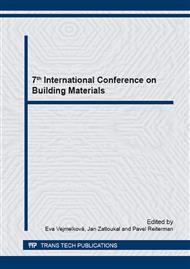[1]
D. Koňáková, V. Hovorková, E. Vejmelková, M. Keppert and R. Černý, 2014, Influence of Metashale as Cement Replacement on the Hygric Transport Properties of Concrete, Advanced Materials Research, Vol. 1054, pp.188-193.
DOI: 10.4028/www.scientific.net/amr.1054.188
Google Scholar
[2]
Ch. Sadik, IEE. Amrani, A. Albizane, Recent advances in silica-alumina refractory: A review. Journal of Asian Ceramic Societies 2 (2006) 83-96.
DOI: 10.1016/j.jascer.2014.03.001
Google Scholar
[3]
ID. Katsavou, MK. Krokida, IC. Ziomas, Determination of mechanical properties and thermal treatment behaviour of alumina-based refractories. Ceramics International 38 (2012) 5747-5756.
DOI: 10.1016/j.ceramint.2012.04.021
Google Scholar
[4]
M. Jogl, P. Reiterman, O. Holčapek, J. Koťátková, 2014, Proposal of Fire Resistant Composites with Application of Lightweight Aggregate Liaver, Advanced Materials Research, Vol. 1054, pp.43-47.
DOI: 10.4028/www.scientific.net/amr.1054.43
Google Scholar
[5]
R. Siddigue, J. Klaus, Influence of metakaolin on the properties of mortar and concrete: A review. Applied Clay Science 43 (2009) 392-400.
DOI: 10.1016/j.clay.2008.11.007
Google Scholar
[6]
E. Vejmelková, D. Koňáková, M. Čáchová, M. Keppert, R. Černý, Effect of hydrophobization on the properties of lime–metakaolin plasters, Construction and Building Materials 37 (2012) 556–561.
DOI: 10.1016/j.conbuildmat.2012.07.097
Google Scholar
[7]
EO. Eze, SA. Onabanjo, Heating effects on physical and strength characteristics of fireclay from the Nigerian Coal Measures Formation. Applied Clay Science 9 (1995) 397-406.
DOI: 10.1016/0169-1317(94)00024-k
Google Scholar
[8]
PL. Jain, Principles of Foundry Technology (4th, revised ed. ), Tata McGraw-Hill 2003, ISBN 978-0-07-044760-8.
Google Scholar
[9]
Information on http: /www. secar. net/-Brochures.
Google Scholar
[10]
T. Kulovaná, E. Vejmelková, M. Keppert, P. Konvalinka and et al, Mechanical and durability properties of concrete with pozzolanic admixture. Thermophysics, Brno: University of Technology, 2012, pp.90-97. ISBN 978-80-214-4599-4.
Google Scholar
[11]
R. Boris, V. Antonovich, R. Stonis, A. Volochko and I. Belov, Effect of holding temperature on properties of different types of heat-resistant concrete. Refractories and Industrial Ceramics 54 (2014) 397-400.
DOI: 10.1007/s11148-014-9619-x
Google Scholar
[12]
O. Holčapek, P. Reiterman, M. Jogl, P. Konvalinka, 2014, Comparison of Refractory and Non-refractory Components in Cement Composites after High Temperatures Load, Advanced Materials Research, Vol. 1054, pp.33-36.
DOI: 10.4028/www.scientific.net/amr.1054.33
Google Scholar
[13]
M. Keppert, K. Polozhiy, 2014, Residual strength of thermally loaded mortars with treated Municipal Solid Waste Incineration fly ash used as Supplementary Cementitious Material, Advanced Materials Research, Vol. 982, pp.114-118.
DOI: 10.4028/www.scientific.net/amr.982.114
Google Scholar


